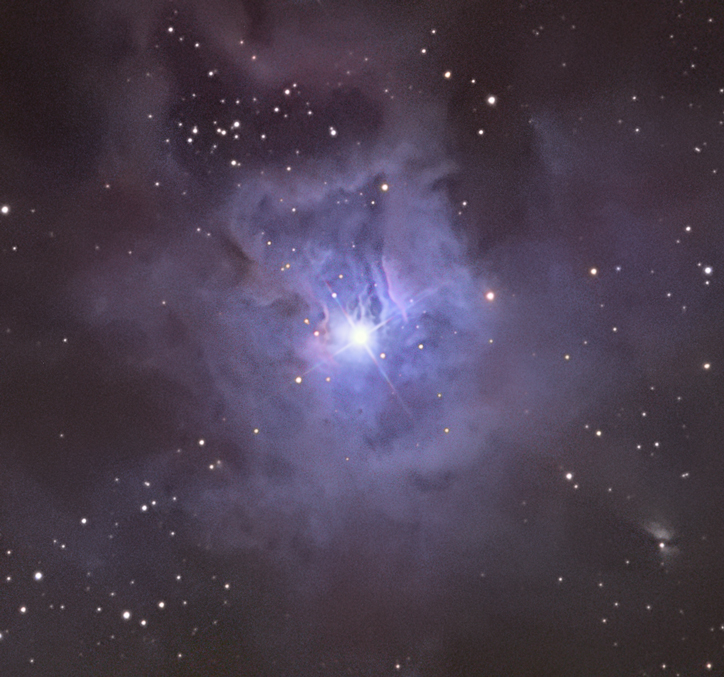Iris Nebula (LBN 487 / VDB 139) with associated open cluster
NGC 7023
Characteristics:
Distance: 1,300 light years
RA: 21h 01m 31s
Dec: +68 degrees 10' 37"
PA: plus 237 degrees
Description:
The Iris Nebula is an interesting and beautiful reflection nebula in
the constellation Cepheus. Discovered by Herschel in 1794, this
object is often mistakenly labeled for its associated open star cluster
NGC 7023, which is present in the triangular "top hat" just above
center in the image. The Iris Nebula (LBN 487 / VDB 139) is
illuminated by a central hot star named SAO 19158 (aka HD 200775),
which is 10 times the mass of our sun. Although not officially
designated as an emission nebula, closer examination of the above image
will reveal a linear ridge on either side of SAO 19158 that represents
HII emission. In addition to this small emission region, there is
a much more extensive reflection component comprised of microscopic
dust particles that preferentially scatter blue light from the central
star. The peripheral regions are comprised of reddish dust that
obscures light from background stars.
In the center of the nebula, there are several ruddy-colored wisps and
filaments of dust that emit broad band red light, instead of reflecting
the more typical blue light of a reflection nebula. These red
regions represent extended red emission (ERE), which is a type of
phospholuminescence associated with dust particles that are bombared by
high energy UV radiation from SAO 19158. Recent investigation of
this region has revealed radiation in the near infrared range of the
spectrum, thought to be related to the presence of polycyclic aromatic
hydrocarbons in this region of space. The Hubble Space Telescope
imaged the central portion of the Iris Nebula in December of 2009,
which I superimposed upon my image in this rollover,
along with a link to the original Hubble
report.
More information regarding the Iris Nebula may be found on Rob
Gendler's
website.
Photographic
Details:
Date: July 2 and 3, 2010 (Luminance); August 6 and 7 (RGB)
Scope: Vixen VC200L at f6.4 on the
Takahashi NJP
Mount
Autoguider: SBIG ST-402
Camera: ST8300 -15C
Filters: Baader L, R,
G, B filters
Exposures: Lum- 70 x 5' = 350';
R- 15 x 8' = 120'; G- 10 x 10' = 100'; B- 12 x 15' = 180'. Total exposure 12.5
hours
Post-processing:
Calibrated in Maxim, aligned and
stacked using DeepSkyStacker, followed
by DDP
in ImagesPlus (IP). Further processing in Photoshop CS5.
Please
note: Graphics on this website may not be reproduced without
author permission.
Back to Nebulae
Home
